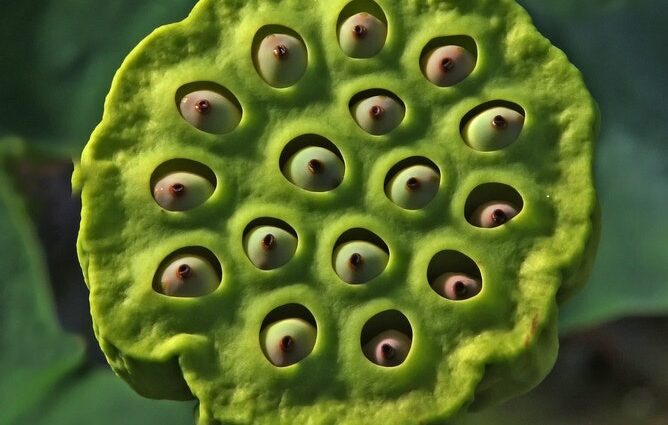Contents
Trypophobie
Trypophobia is a little known but common phobia. This panicked and irrational fear of small holes can be treated with behavioral therapy.
Trypophobia, what is it?
Definition
Trypophobia is the phobia of all closely spaced geometric shapes (circular or convex, holes), like what can be seen in a honeycomb, in shampoo foam, in a piece of Swiss cheese …
The word trypophobia comes from the Greek trupe, hole and phobos, fear. It is a “phobia” which has been recently identified without being officially classified as a phobia (intense and irrational fear accompanied by flight). It was indeed described for the first time in 2005. It would affect many people.
Causes
Researchers see in this phobia the possible inheritance of a flight reflex registered in the nervous reflexes of our ancestors in front of groupings of circles recalling the drawings of the skin of dangerous animals (snake, poisonous octopus…).
Other scientists explain this phobia by the fact that very close geometric shapes evoke symptoms of infectious or parasitic diseases (smallpox, measles, typhus, scabies, etc.) or of decomposition.
In both cases, trypophobia would therefore be linked to an evolving defense mechanism (recognizing and therefore fleeing dangerous animals or sick people).
Diagnostic
The diagnosis of tryphobia is medical although it is not officially recognized as a phobia. A phobia meets specific diagnostic criteria. The health professional consulted can establish a list of the situations or objects at the origin of the phobia (here in this case the very close geometric shapes including holes, associated emotions, physical behavior, then he / she is interested in the symptoms. It can be based on specific questionnaires which assess the existence and intensity of recognized phobias.
The people concerned
Trypophobia is said to affect many people. According to a study carried out by researchers at the University of Essex in England, 11% of men and 18% of women are affected. There are Facebook groups with thousands of people discussing this phobia.
Risk factors
Little is known about the risk factors for trypophobia. Some studies have made a link between trypophobia and depressive disorders or between tryphobia and social anxiety. People with these disorders are more likely to have trypophobia.
Symptoms of trypophobia
Symptoms of trypophobia are common to other phobias.
Unreasoned fear and panic in the face of the object in question
People with trypophobia feel a very strong fear or anxiety when they see a sponge, corals, soap bubbles …
This fear is persistent and also triggered by the anticipation of the phobic object (when one knows one is going to be confronted with it). The person who suffers from a specific phobia such as trypophobia is also aware of the unreasonable nature of his fear and suffers from it.
Anxiety responses
Faced with holes, the person suffering from trypophobia can experience many disorders: accelerated heartbeat, feeling of breathlessness, nausea, sweating, chills or hot flashes, tremors, dizziness … In some cases, the phobia can give rise to real panic attacks.
The phobia is characterized by avoidance of the object or situation causing the phobia.
You do everything to avoid finding yourself in the presence of the object (here the holes) at the origin of your phobia.
Treatment of trypophobia
Like other phobias, trypophobia is treated by following cognitive behavioral therapy. This therapy aims to expose you to what causes your phobia, from afar and in a reassuring setting and then closer and closer to make the fear disappear. The fact of being confronted with the phobogenic object in a regular and progressive way rather than avoiding it makes it possible to make the fear disappear.
Psychoanalysis can also be effective
Medication for anxiety disorders can be prescribed, but they are not a solution in themselves. They just make it possible to cope with very intense phobic symptoms.
Phobia, natural treatments
Essential oils with calming and relaxing properties can help prevent anxiety cures. You can use for example by cutaneous or olfactory way essential oils of sweet orange, neroli, small grain bigarade.
Prevent trypophobia?
It is not possible to prevent a phobia. The only prevention to avoid intense fear and symptoms is to avoid the object of the phobia.
On the other hand, it is important to be able to get help as soon as the symptoms of phobia appear because, if left untreated, it can become disabling.










